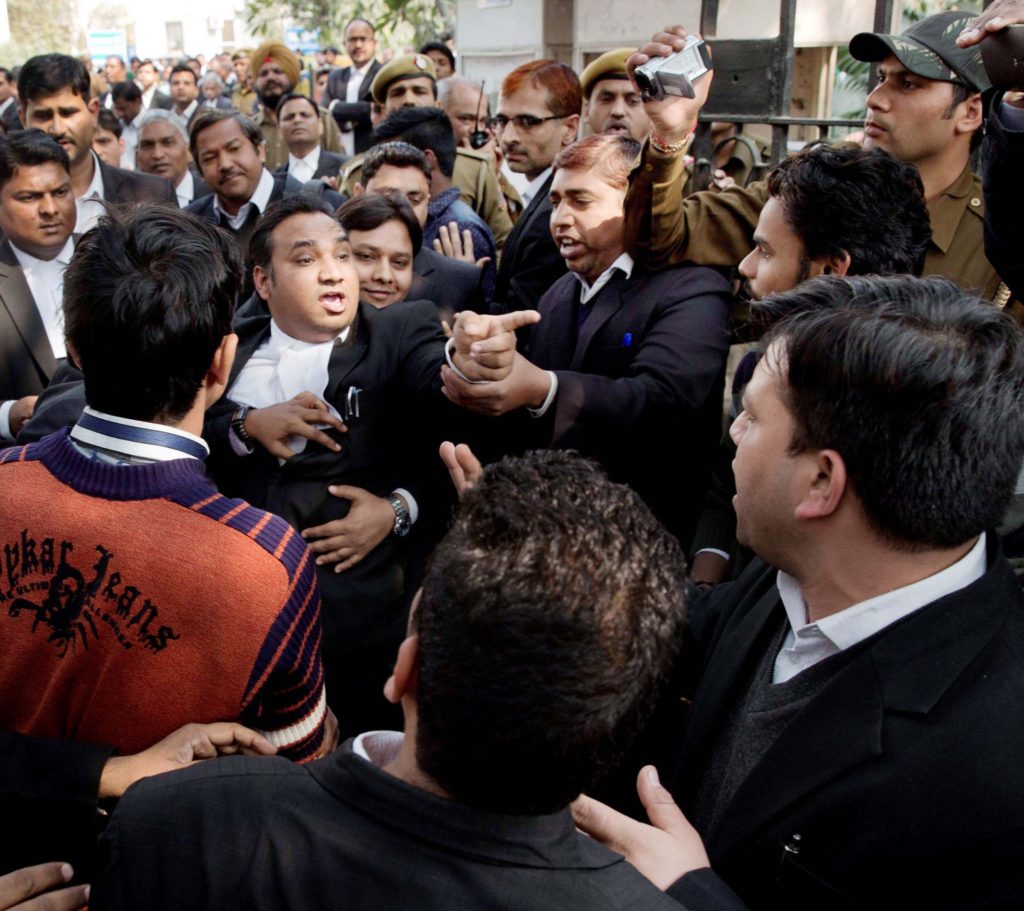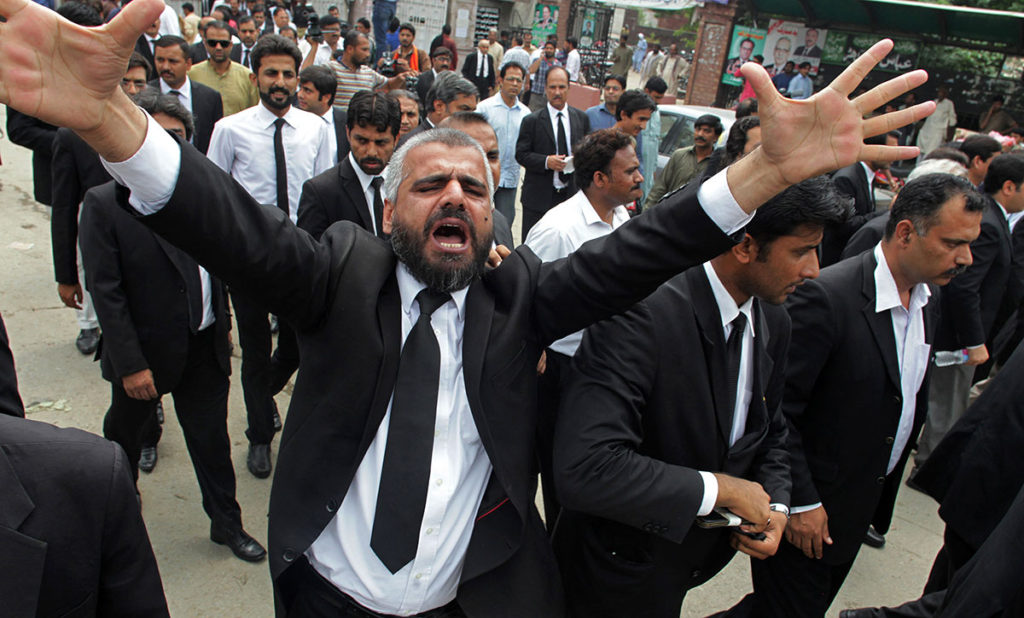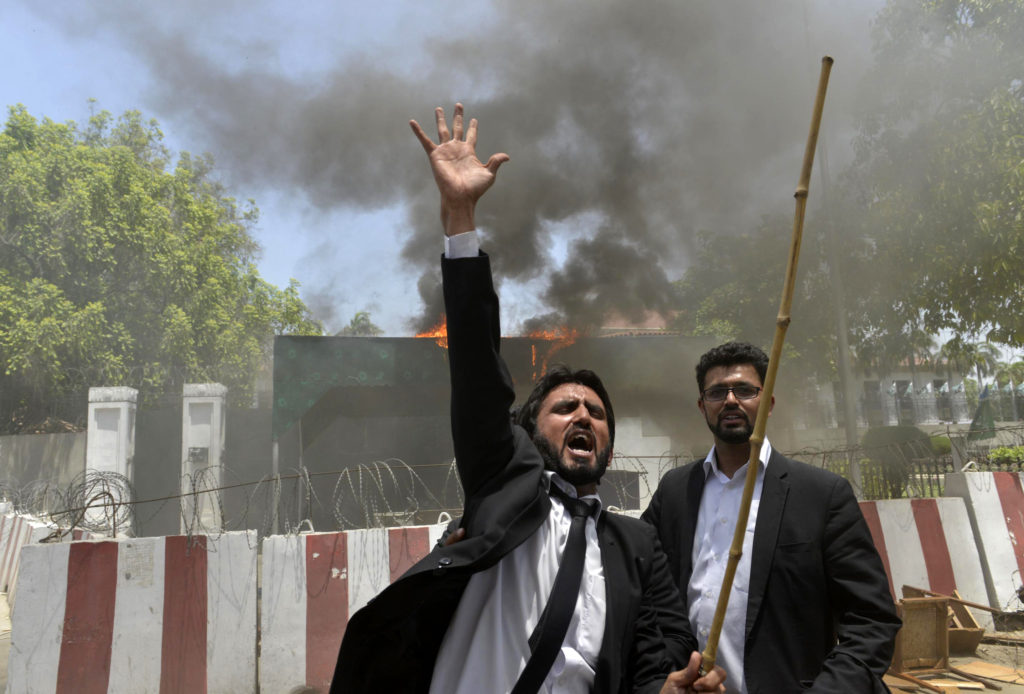A Law Unto Themselves
By Adnan Adil | Cover Story | Published 8 years ago
 Lawyers’ clashes with the subordinate judiciary are becoming increasingly commonplace in Pakistan, Punjab in particular, but the latest episode spiralled into a mega crisis, with lawyers’ misbehaving with the Chief Justice (CJ) of the Lahore High Court (LHC) and rioting on the premises of the superior court.
Lawyers’ clashes with the subordinate judiciary are becoming increasingly commonplace in Pakistan, Punjab in particular, but the latest episode spiralled into a mega crisis, with lawyers’ misbehaving with the Chief Justice (CJ) of the Lahore High Court (LHC) and rioting on the premises of the superior court.
It started on July 24 when a group of seven lawyers, led by the President of the Multan High Court Bar Association, Sher Zaman Qureshi, appeared before Justice Qasim Khan in the Multan bench of the LHC with a plea relating to the rebuilding of a mosque situated on the metro bus route in Multan city which had been demolished to establish the bus track. Around 25 other lawyers who were party to the plea had submitted their powers of attorney to the lawyers appearing in the case.
The lawyers crowded before the judge in the courtroom — standard practice for certain lawyers, especially officials of bar associations and aspiring candidates — to put pressure on the judges to give a decision in their favour. Justice Qasim asked them to return to their seats and stipulated that the advocates should present their case one at a time. This incensed Advocate Sher Zaman Qureshi, who misbehaved with the judge, forcing him to leave the courtroom. Subsequently, taking cues from Qureshi, the other lawyers proceeded to tear down the judge’s nameplate from outside the door, and Advocate Qaiser Abbas Kazmi, allegedly trampled the nameplate with his feet. The lawyers also raised slogans against Justice Qasim Khan in the corridors of the court, as is visible in a video clip made of the incident. They then proceeded to take out a protest procession against the judge on the streets.
The same day (July 24) the CJ, LHC, Syed Mansoor Ali Shah, took suo moto action against this incident, summoned all the judges working in the Multan bench to the principal seat in Lahore, and permitted the filing of cases pertaining to Multan region at the principal seat and at the Bahawalpur bench. Two days later, however, the CJ gave the Multan bench the green signal, permitting them to entertain cases there from July 27 onwards.
The judges resumed work in the Multan bench from July 31, but the lawyers boycotted the Multan bench indefinitely, demanding that a contempt of court notice be issued to Justice Qasim Khan and others, and that the suo moto action against them be withdrawn. The Multan bar officials said the CJ of the LHC did not have the powers to suspend the Multan bench and call them to the principal seat, and that they would move the Supreme Judicial Council against Syed Mansoor Ali Shah over this issue.
On July 27, the LHC issued a show-cause notice for contempt of court against Sher Zaman Qureshi and Qaiser Abbas Kazmi and asked them to appear before a five-member bench of the LHC on July 31 at the principal seat. Neither of the accused turned up on the appointed date. At the request of the President of the LHC Bar Association, the LHC bench adjourned the matter till August 2, and ordered the two accused lawyers to appear before it.
On August 2, a group of lawyers, including some candidates for the upcoming elections for the District bar Association, Lahore, and a candidate for the post of President, Supreme Court Bar Association, raised slogans against LHC CJ, Mansoor Ali Shah, in his courtroom. The bench adjourned the case because of their unruly behaviour. The accused lawyers again failed to appear before the bench. At the request of the LHC Bar Association, the bench adjourned the matter for the second time and asked the accused to appear on August 11.

On August 11, the matter was adjourned for the third time till August 21, because the accused lawyers did not appear before the court once again. The Bar Councils then promised to take action against Advocate Qureshi and promised to disassociate from him if he did not appear on the next date. On August 21, Advocate Kazmi, who had been given a last warning to appear in court at the previous hearing, appeared before the court, but Advocate Qureshi chose to stay away. Chief Justice LHC, Mansoor Ali Shah, responded by issuing a non-bailable arrest warrant for Qureshi, which enraged a section of the legal community.
The only legal remedy against this order available to Advocate Qureshi was to move the SC for bail, or to present himself before the five-member enquiry committee bench. But instead of choosing the legal path, he, along with his fellow lawyers, resorted to violence, and a confrontation with the judiciary.
Soon after the court order, a mob of around 100 protesting lawyers attacked the LHC. The mob broke past the judges’ entry gate of the LHC and threw stones at the policemen deployed inside the High Court premises. The emotionally charged lawyers then assembled outside the LHC judges’ iron gate in an attempt to block the exit of CJ Mansoor Ali Shah and other judges from the court. However the Rangers, deployed for the security of the premises, managed to stop them from entering.
The police, unable to contain the rioting lawyers, finally had to resort to the use of water cannons and tear gas to disperse them from the premises of the LHC. The lawyers then marched on The Mall and staged a sit-in. The next day lawyers all over the country went on strike and boycotted the courts.
That the bar stands polarised in the dispute, is evidenced by the fact that only a minority condemned the hooliganism. Although some senior lawyers expressed displeasure over the rioting by lawyers, they did not defend the High Court’s contempt proceedings against the President of the Multan Bar. The Punjab Bar Council did not protest against the conduct of the lawyer in question. Nor did it ask the Multan Bar President for an explanation of the matter. It took no notice of the fact that the Bar President and his colleagues misbehaved with the judge in the courtroom and then adopted goonda (hooligan) tactics.
In fact, the Supreme Court Bar Association (SCBA) issued a statement referring to the hooliganism in Multan as “petty events,” and called Chief Justice Mansoor Ali Shah’s actions “disgraceful.” However, 85 advocates and retired judges responded with a letter to the SCBA, asking it to speak out against the vandalism of lawyers from Multan and uphold the rule of law.
Meanwhile, Pakistan Bar Council member, Ishtiaq Khan, said that a High Court does not have the jurisdiction to initiate contempt proceedings against a lawyer involved in alleged misconduct. He argued that respective bar councils were the appropriate forums to deal with such cases under the Legal Practitioner & Bar Councils Act 1973.
Former President of the LHCBA’s Multan Bench, Qamarul Zaman Butt, contended that Advocate Sher Zaman Qureshi did not appear before the court as he did not commit contempt of court and the action being taken by the LHC CJ was malafide and illegal. He said since the incident occurred in Multan, only the concerned judge could initiate contempt proceedings, not the Chief Justice of the Lahore High Court.
And some lawyers maintained that High Courts are not entitled to take suo moto action as per a judgement of the SC, but the LHC violated this principle by taking action against Qureshi on its own. They also said that the CJ of the LHC could have resolved the issue through an administrative committee, but instead, he summoned the President of the Multan Bar in open court on contempt charges, which was humiliating for the legal community. They added that lawyers are also law officers of the court and are entitled to the same respect and honour enjoyed by the judges. Bar representatives also maintain that several lawyers had filed written complaints against the misbehaviour of Justice Qasim Khan with lawyers prior to this episode.
Finally, in late August, in defiance of the LHC’s larger bench, a committee of the Punjab Bar Council (PBC) announced the restoration of Sher Zaman Qureshi’s practicing license. The bar committee said that the LHC had no power to initiate contempt proceedings against the Multan bar president and suspend his license. Given the impasse, the dispute between the High Court and the bar might now land up in an even higher forum for resolution: the Supreme Court.
Some senior advocates say that had the action taken, in the case of the President of the Multan Bar, been less strict, the issue would not have spiralled to the level of violence it did on August 21. They allege that the relations between the bar and the bench deteriorated owing to the ego of a certain judge.
Clashes between members of the judiciary are not unusual, but these have been on the rise since the lawyers’ movement in 2007. It has become normal for lawyers practicing in lower courts to insult judges and lock them in courtrooms in case they do not provide instant relief in the cases they are representing. In many cases, judges of the lower courts have been transferred under the pressure of the bars.

Pakistani lawyers shout slogans after burning the entrance to the provincial assembly in Lahore
Since the lawyers’ movement in 2007, a sense of being a privileged community has emerged among sections of the bar, as it was their agitation that led to the restoration of Chief Justice Iftikhar Chaudhry in March 2009 and earlier also weakened General Pervez Musharraf’s position. This movement gave lawyers a sense of power and a notion that the judiciary owes its existence and authority to the lawyer’s street power. The violent behaviour of lawyers has now reached such proportions that not even a respected Chief Justice of a High Court is safe from the rage of the black coats who are certain they have the weight of the entire bar behind them. In the past, the judiciary has invariably eaten humble pie over such disputes for the simple reason that the number of judges is only a small fraction of the number of lawyers in the country. For example, there are more than 100,000 lawyers in the Punjab, as compared to a couple of thousand senior and junior judges. Lawyers are organised and have street power which judges do not have.
They, however, discount the power of a resurgent judiciary. In the past, when lawyers clashed with subordinate judges, the latter invariably found themselves on the wrong foot. But this time round the lawyers fell foul of an assertive Chief Justice of a High Court. CJ Mansoor Ali Shah has introduced many reforms which have had a positive impact on the dispensation of justice in the Punjab. For example, he has enhanced the monitoring of the subordinate judiciary in Punjab to reduce the delay in the adjudication of cases and the redressal of complaints of corruption. The High Court’s records are being digitalised and a lot more information about cases is now available online.
The exigencies of bar politics can also be blamed for the kind of lawyers’ violence that took place in Lahore. The confrontation between the bar and the bench could have been better handled had some widely-respected members of both intervened. The issue is that leaders of the community generally look the other way at the contemptuous conduct of some of their junior colleagues towards judges, and the hooliganism that often follows, for the reason that they are dependent on the support and activism of these elements for winning bar elections. Worse, they have started actively protecting mob behaviour. Crores of rupees are spent each year on the election of bar councils as bar members wield influence and get highly paid cases owing to their status in the community.
The ganging up of a large section of lawyers against a Chief Justice and their frequent resort to violence and the use of extra-legal means to assert their complaints shows the extent to which lawlessness exists among them and the degree to which bar councils have become hostage to black sheep in black coats.


